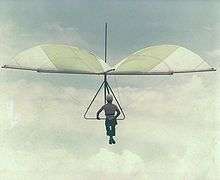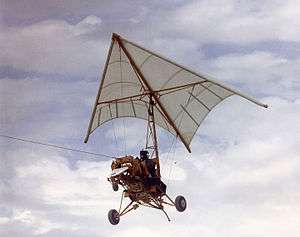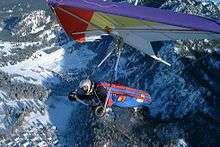John W. Dickenson
John Wallace Dickenson AM (born 22 January 1934) is an Australian inventor, who developed some liquid flow measuring devices[1] and designed a successful hang glider configuration,[2] for which he was awarded with the Gold Air Medal,[3] the highest award given by the Fédération Aéronautique Internationale, the world governing body for air sports, aeronautics and astronautics world records.
John W. Dickenson | |
|---|---|
| Born | John Wallace Dickenson 22 January 1934 |
| Nationality | Australia |
| Occupation | inventor |
| Known for | modern hang glider |

Ski kite

In 1963, after seeing an image of a Rogallo wing airfoil on a magazine, Dickenson set to build a water skiing kite[4] that could be released at altitude for a glide to a safe drop in the water, thus designed and built a water skiing kite wing he called the Ski Kite.[5][6][7]
His ski kite format incorporated an airframe with a triangle control frame as used in hang gliding in Breslau 1908, having a basebar tow-point and was integrated on an all-ready publicized four-boom stiffened Rogallo wing airfoil, where the pilot sat on a swinging seat while the control frame and wire bracing distributed the load to the wing as well as giving a frame to brace for weight-shift control.[8][9] Dickenson's Ski Wing turned out to be stable and controllable, unlike the flat manned kites used at water ski shows.[10] The Ski Wing was first flown in public at the 'Grafton Jacaranda Festival', New South Wales, Australia, in September 1963 by Rod Fuller while towed behind a motorboat.
The ski kite he now called Ski Wing, was light and portable, so Dickenson decided to file for a mechanical patent, but lacking on economic resources, the patent process of formal review of claims could not be entered to determine which, if any, of the claims could hold, so the patent was not awarded.[11]
Glider versions
Half scale prototype
Produced in 1963
Mark I
Produced on 8 September 1963. Features:
- Wing: biconical flexible wing
- Keel and leading edge length: 16 feet (5 m)
- Keel and leading edge: rigid
- Cross bar: rigid
- Control type: pendulum weight shift
- Pendulum attachment: single line
- Control bar: square frame
- Pilot support: seat
- Side wires: 8
Materials:
- Wing surface: banana bag plastic
- Leading edge and keel : 1 ½ inch wood, Oregon douglas fir
- Cross bar:"cross bar was a length of T.V. antenna, with a length of turned wood jammed into it to give it the required strength"[12]
- Leading edge attachment:'D-section' wood and nails
- Cable: clothesline wire
Mark I with A-frame
Produced in September 1963.
Change: control A-frame added.
1963 October – Flown at the Jacaranda Festival in Grafton, New South Wales, Australia.
1963 Oct 11 – Provisional patent filed.
Mark II
Produced in January 1964.
Changes: All aluminium frame, leading edge and keel.
Length: 14 feet (4 m)
Mark III
Produced in March 1964.
Changes: Back to wooden leading edge and keel.
Leading edge and keel length <14 feet (4 m)
Mark IV
Produced in November 1964.
Changes: sewn sail.
Diagrams of this sent to Francis Rogallo at NASA.
In 1965, John leaves Grafton for Sydney.
Mark V
Produced between 1967 – 1968.
Changes: built by Aero Structures.
1969 April – Bill Moyes at NSW, Australia sets ridge soaring record at 32 minutes. Australia.[13]
Legacy
Certainly Rogallo and I provided the hardware.
— John W. Dickenson.[14]

Dickenson's hang glider format was further developed by other builders and directly helped to build the popularity of hang gliding around the world in the 1970s and 1980s.[15][16][17][18][19][20][21][22][23][24][25]
It is certain that many people from many countries, made contributions to the development of the flexible wing hang glider to the extent that any global mechanical claim for invention would be untenable. In the aviation context of 'first flights' and recreational vs. commercial developments, new and old inventions often complement in synergy; it is in this evolutionary and social context that the crucial developments put together John Dickenson, were the ones that were most successful and influential on the evolution of hang gliders.[5][26] John Dickenson was a ski-kite pilot; he never foot-launched a hang glider.
Awards
Most recognitions and awards have been given to Dickenson decades after his invention:[27]
- 'Life Membership' to the Hang Gliding Federation of Australia (1993)
- 'Certificate of Recognition' by the British Hang Gliding & Paragliding Association (1993)
- Space Technology Hall of Fame (1995)
- Order of Australia (1996)[28]
- Grafton Town Memorial, NSW Australia (2006)
- 'Certificate of Recognition' by the Hang Gliding Federation of Australia (2006)
- The Fédération Aéronautique Internationale Hang Gliding Diploma (2006) for the invention of the modern hang glider.[29]
- The Fédération Aéronautique Internationale Gold Air Medal (2012).[3][30]
- Oswald Watt Gold Medal (2012)[31]
- "Flex-Wing Hang Glider Gold Air Award" by the World Hang Gliding Association (2013)[26]
See also
References
- "John Dickenson's Other Inventions". Johndickenson.net. Retrieved 18 July 2016.
- "Kites of John Dickenson – Hang Gliding Wiki". Hanggliding.org. 9 July 2010. Retrieved 18 July 2016.
- "The FAI Gold Air Medal for John Dickenson". Fédération Aéronautique Internationale. 19 July 2012. Archived from the original on 22 August 2012.
- "Water skiing kite". Daily Examinar. Grafton, NSW, Australia. 21 October 1963. p. 1.
- Lukasch, Bernd (2 June 2000). "To fly like a bird". Retrieved 12 August 2008.
- Skyvington, William. "Grafton's Ski Wing". Retrieved 13 August 2008.
- Fogg, Chris (2006). "History – Grafton, Jacaranda Festival and John Dickenson". Hang Gliding Federation of Australia. Archived from the original on 23 July 2008. Retrieved 13 August 2008.
- Woodhams, Mark (May 2004). "Who invented the flex wing hang glider?". Newsletter of the British Columbia Hang Gliding and Paragliding Association. Archived from the original on 9 May 2008. Retrieved 12 August 2008.
- "Rogallo "Sail Wing" Hang Glider". Western Museum of flight. Archived from the original on 2 June 2008. Retrieved 12 August 2008.
- Stability and weight-shift control are inherent flex-wing characteristics previously established and described by its inventor Francis Rogallo and by NASA engineers in the Paresev and Fleep programs.
- On October/11/1963, Dickenson filed for a patent, and a provisional protection was awarded for his application number 36189/63 but the patent was not awarded: "John Dickenson – Profits left hanging by glider" (PDF). InovatED. Archived from the original (PDF) on 31 August 2007. Retrieved 12 August 2008.
- "Australian Hang Gliding History. A Article by Graeme Henderson". Australian-hang-gliding-history.com. Retrieved 18 July 2016.
- Footage: , Interview: Archived 27 September 2007 at the Wayback Machine
- An interview with Francis Rogallo, John Dickenson, and Bill Moyes in 1988 on YouTube
- Otto-Lilienthal-Museum. "Otto-Lilienthal-Museum Anklam". Lilienthal-museum.de. Retrieved 18 July 2016.
- "Archived copy". Archived from the original on 19 August 2007. Retrieved 17 August 2007.CS1 maint: archived copy as title (link)
- "Archived copy". Archived from the original on 5 July 2007. Retrieved 17 August 2007.CS1 maint: archived copy as title (link)
- "Archived copy". Archived from the original on 17 August 2007. Retrieved 17 August 2007.CS1 maint: archived copy as title (link)
- "Archived copy". Archived from the original on 5 July 2007. Retrieved 17 August 2007.CS1 maint: archived copy as title (link)
- "Archived copy". Archived from the original on 5 July 2007. Retrieved 7 August 2007.CS1 maint: archived copy as title (link)
- "Archived copy". Archived from the original on 18 January 2008. Retrieved 7 August 2007.CS1 maint: archived copy as title (link)
- "Archived copy". Archived from the original on 29 September 2007. Retrieved 7 August 2007.CS1 maint: archived copy as title (link)
- "Archived copy". Archived from the original on 29 September 2007. Retrieved 7 August 2007.CS1 maint: archived copy as title (link)
- "Hang Gliders:". Abc.net.au. 25 October 2004. Retrieved 18 July 2016.
- "Resume of film and television experience highlights – Mike Harker". H-tv.com. Archived from the original on 3 March 2016. Retrieved 18 July 2016.
- "Flex-Wing Hang Glider Gold Air Award by WHGA". Energykitesystems.net. Retrieved 18 July 2016.
- "John Dickenson Awards". Johndickenson.net. Retrieved 18 July 2016.
- "Archived copy" (PDF). Archived from the original (PDF) on 31 August 2007. Retrieved 12 August 2008.CS1 maint: archived copy as title (link)
- "Archived copy". Archived from the original on 18 May 2011. Retrieved 5 February 2016.CS1 maint: archived copy as title (link)
- Robertson, James (25 August 2012). "Inventor hangs in there to finally soar to glory". Sydney Morning Herald. Retrieved 27 August 2012.
- "Oswald Watt Gold Medal Winners" (PDF). Rfaca.com.au. Retrieved 18 July 2016.
External links
- Video: Interview with John Dickenson, Bill Moyes and Francis Rogallo (1988) on YouTube
- Video: Flexible wing. Interview with Francis Rogallo on YouTube. NASA Destination- Tomorrow, segment explaining the history of the flexible wing and of the hang glider.